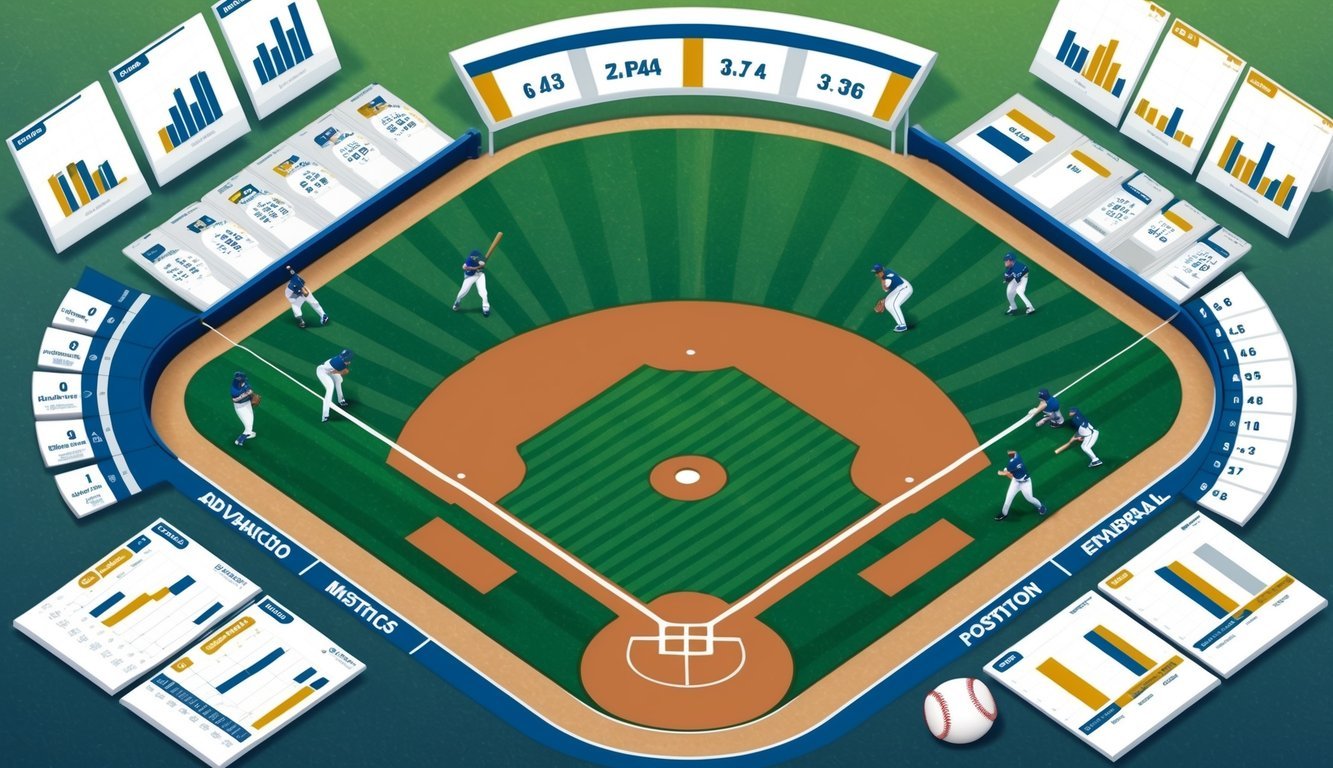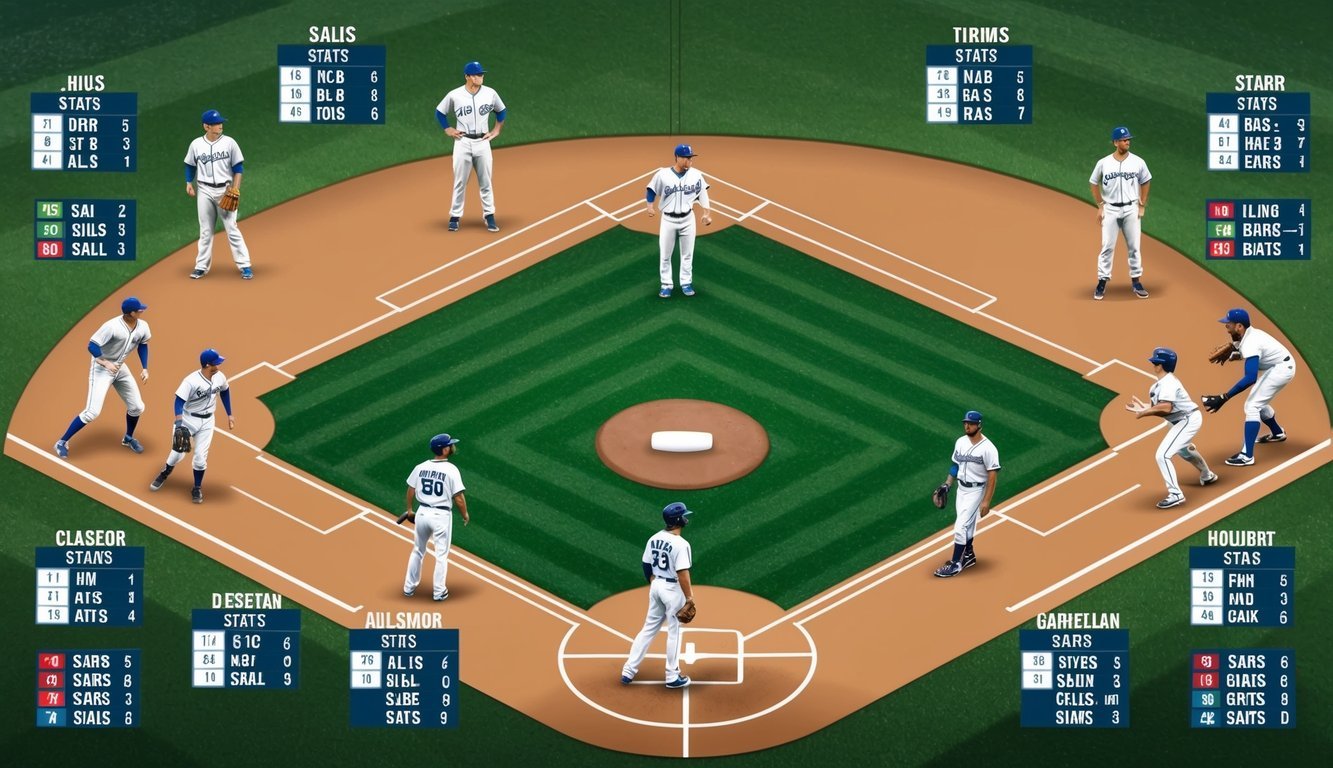Baseball fans love to talk stats, but the abbreviations can be confusing for newcomers.
From AVG to OPS, the world of baseball statistics is filled with cryptic shorthand.
These abbreviations represent important metrics that measure player performance and team success.
Understanding baseball stat abbreviations is essential for fully appreciating the game and evaluating players.
Common batting stats include AVG (batting average), HR (home runs), and RBI (runs batted in).
For pitchers, key abbreviations are ERA (earned run average), K (strikeouts), and WHIP (walks plus hits per inning pitched).
As the game has evolved, so have the stats.
Advanced metrics like OPS (on-base plus slugging) and WAR (wins above replacement) offer deeper insights into player value.
Knowing these abbreviations helps fans engage in more meaningful discussions about their favorite teams and players.
Fundamentals of Baseball Statistics
Baseball statistics provide crucial insights into player and team performance.
They help fans, coaches, and analysts evaluate different aspects of the game quantitatively.
Pitching Stats
ERA (Earned Run Average) is a key metric for pitchers.
It measures the average number of earned runs a pitcher allows per nine innings.
A lower ERA indicates better performance.
IP (Innings Pitched) tracks how long a pitcher stays in the game.
This stat is important for assessing a pitcher’s endurance and effectiveness over time.
Strikeouts (K) and walks (BB) reveal a pitcher’s control and ability to fool batters.
A high K/BB ratio is generally desirable.
Meanwhile, WHIP (Walks plus Hits per Inning Pitched) shows how many baserunners a pitcher allows.
It’s a good indicator of overall pitching effectiveness.
Batting Stats
BA (Batting Average) is the most basic hitting stat.
It’s calculated by dividing hits by at-bats.
A .300 BA is considered excellent.
OBP (On-Base Percentage) includes walks and hit-by-pitches.
It measures how often a batter reaches base safely.
SLG (Slugging Percentage) reflects power hitting.
It’s calculated by dividing total bases by at-bats.
OPS (On-Base Plus Slugging) combines OBP and SLG.
It’s a comprehensive measure of a batter’s offensive production.
Finally, RBI (Runs Batted In) counts how many runs a batter drives in.
It’s important for assessing a player’s contribution to scoring.
Fielding Stats
FP (Fielding Percentage) measures a player’s defensive reliability.
It’s calculated by dividing successful chances by total chances.
Errors track defensive mistakes.
A low error count indicates good fielding skills.
Then, assists and putouts show a player’s involvement in defensive plays.
These stats vary by position.
Lastly, range factor measures a fielder’s defensive coverage.
It’s calculated by dividing putouts and assists by innings played.
Meanwhile, Defensive Runs Saved (DRS) is an advanced stat that estimates a player’s total defensive value compared to an average fielder.
Advanced Metrics

Baseball has evolved beyond traditional stats to include sophisticated measures of player performance.
These advanced metrics provide deeper insights into offensive, pitching, and defensive capabilities.
Offensive Advanced Stats
OPS combines on-base percentage and slugging percentage, offering a quick view of a batter’s overall effectiveness. wOBA weighs different offensive actions based on their run value, while ISO measures a hitter’s raw power by looking at extra-base hits.
Runs Created estimates how many runs a player contributes to their team.
It factors in all offensive actions, from hits to walks.
Meanwhile, OPS+ compares a player’s OPS to the league average, adjusting for park factors.
Lastly, Total Bases sums up all hits, giving more weight to extra-base hits.
It’s a simple yet effective way to gauge offensive production.
Pitching Advanced Stats
WHIP (Walks plus Hits per Inning Pitched) indicates how many baserunners a pitcher allows.
A lower WHIP suggests better performance.
Meanwhile, FIP (Fielding Independent Pitching) estimates ERA based on outcomes a pitcher directly controls.
K/9 measures strikeouts per nine innings, showing a pitcher’s ability to miss bats.
Then, BB/9 tracks walks issued, reflecting control.
Lastly, HR/9 reveals home run vulnerability.
Finally, xFIP adjusts FIP by normalizing home run rates, useful for predicting future performance.
Meanwhile, SIERA considers batted ball types for a more comprehensive pitching evaluation.
Defensive Advanced Stats
UZR (Ultimate Zone Rating) quantifies fielding skill by comparing plays made to league average.
It accounts for the difficulty of each play.
DRS (Defensive Runs Saved) measures fielding impact in runs above or below average.
OAA (Outs Above Average) uses Statcast data to evaluate fielding range and efficiency.
It’s particularly useful for outfielders.
Meanwhile, Catcher Framing stats assess a catcher’s ability to get strike calls on borderline pitches.
Lastly, ARM (Arm Strength) tracks outfielder throwing velocity, crucial for preventing extra bases.
Fielding Percentage remains relevant but doesn’t capture range or play difficulty like advanced metrics do.
Scoring and Game Outcome Stats

Baseball uses various abbreviations to track scoring and game outcomes.
These stats help measure both individual player contributions and overall team performance.
Player Performance
R stands for runs scored, a key offensive stat.
Meanwhile, HR denotes home runs, powerful hits that clear the outfield fence.
Lastly, RBI (runs batted in) credits players for driving in runs.
For pitchers, W and L represent wins and losses.
Meanwhile, SV indicates saves, when a relief pitcher preserves a close lead.
Lastly, HLD means hold, awarded to setup pitchers who maintain a lead.
Meanwhile, GF tracks games finished by a pitcher.
Players aim for high R, HR, and RBI totals.
Meanwhile, pitchers strive for more W and SV, with fewer L.
Team Performance
Team stats focus on overall game results.
W-L shows a team’s win-loss record.
PCT represents winning percentage.
Meanwhile, GB indicates games behind the division leader.
CG stands for complete games, when a starting pitcher finishes all nine innings.
Meanwhile, SHO means shutout, a game where the opponent doesn’t score.
Lastly, RS and RA track runs scored and runs allowed by a team.
These stats help calculate run differential, a key indicator of team strength.
Teams aim to maximize W, PCT, RS, CG, and SHO while minimizing L and RA.
Player Positions and Their Stats

Baseball positions each have unique statistical measures that capture performance.
Different roles on the field require tracking distinct metrics to evaluate player contributions.
Infield Player Stats
Infielders are crucial defensive players.
Key stats for these positions include assists (A) and putouts (PO).
An assist occurs when a fielder helps record an out, while a putout is credited to the player who physically records the out.
Errors (E) track fielding mistakes.
Meanwhile, zone rating measures how well a player covers their defensive area.
For example, a shortstop with a high zone rating effectively fields balls hit to their position.
Offensively, infielders are evaluated on batting stats like batting average (AVG) and on-base percentage (OBP).
Some infielders, particularly those at the corners, are also expected to contribute power numbers like home runs (HR) and runs batted in (RBI).
Outfield Player Stats
Outfielders have their own set of important defensive stats.
Putouts are common for outfielders who catch fly balls.
Meanwhile, assists are recorded when they throw out runners trying to advance bases.
Range factor (RF) measures an outfielder’s defensive coverage.
It’s calculated by adding putouts and assists, then dividing by innings played.
A higher RF indicates better field coverage.
Offensively, outfielders often focus on power hitting.
Thus, slugging percentage (SLG) and on-base plus slugging (OPS) are key stats.
Speed is also valuable, with stolen bases (SB) being an important metric for many outfielders.
Pitcher Specific Stats
Pitchers have a unique set of statistics.
Earned run average (ERA) is crucial, measuring the average number of earned runs allowed per nine innings pitched.
Meanwhile, wins (W) and losses (L) track game outcomes credited to the pitcher.
Strikeouts (K) and walks (BB) are important measures of pitcher control and dominance.
Meanwhile, WHIP (walks plus hits per inning pitched) indicates how many baserunners a pitcher allows.
For relievers, saves (SV) and holds (HLD) are key stats.
These measure a pitcher’s ability to preserve leads in late-game situations.
Meanwhile, pitch count and innings pitched (IP) help track pitcher workload and endurance.
Understanding these statistics is crucial for evaluating a reliever’s effectiveness.
For instance, when discussing bullpen performance, one might ask, “what is a hold in baseball? ” A hold is awarded to a relief pitcher who enters the game in a save situation and successfully maintains the team’s lead, showcasing their ability to navigate high-pressure scenarios.
By analyzing these metrics, teams can better assess their pitching depth and strategize for optimal performance.
Understanding Game Dynamics through Stats

Baseball statistics provide valuable insights into the flow and strategy of the game.
They reveal how teams create scoring opportunities and prevent runs through clever base running and defensive tactics.
Base Running
SB (Stolen Bases) tracks a runner’s success in taking an extra base.
Meanwhile, CS (Caught Stealing) measures failed attempts.
A high SB to CS ratio indicates an efficient base stealer.
LOB (Left on Base) shows how many runners a team failed to bring home.
This stat highlights missed scoring chances and can signal offensive struggles.
Lastly, SF (Sacrifice Flies) occur when a batter hits a fly ball that allows a runner to score.
Meanwhile, SH (Sacrifice Hit) or bunt happens when a batter advances runners without reaching base safely.
These plays demonstrate strategic offensive moves.
Defense Mechanisms
DP (Double Play) occurs when the defense records two outs in one play.
It’s a pitcher’s best friend.
It quickly ends threats.
TP (Triple Play) is rare but exciting.
Three outs on one play can instantly shift momentum.
A (Assists) measure how often a fielder helps record an out.
Infielders typically rack up more assists than outfielders.
DER (Defensive Efficiency Rating) shows the percentage of balls in play converted to outs.
It’s a team stat that reflects overall defensive prowess.
These stats paint a picture of the cat-and-mouse game between offense and defense.
They showcase the intricate strategies that make baseball fascinating.
